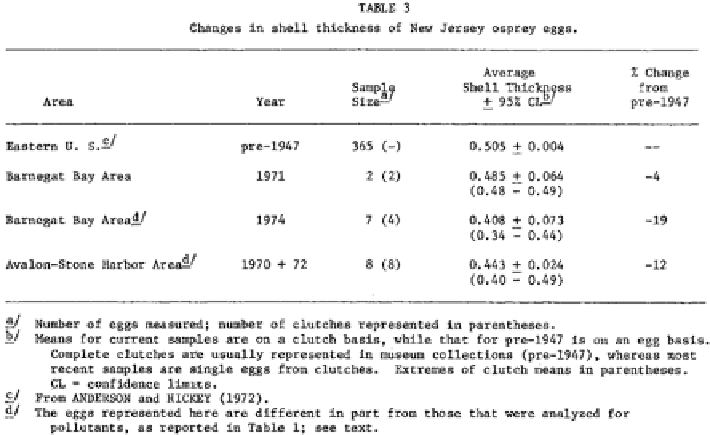Environmental Engineering Reference
In-Depth Information
thinning of eggshells and 0.73 young per female. The lower than normal reproductive
success was not attributed to the eggshell thinning, which was described as near
normal. The fi sh were scraps taken from the same nests as the eggs. The fi sh muscle
was analyzed. A crude biomagnifi cation factor can be calculated as 0.43/0.11 = 3.8.
Whole fi sh would undoubtedly give a lower biomagnifi cation factor. The population
of ospreys in Florida is not migratory, remaining in Florida year-round.
Wiemeyer et al. (
1978
) reported on studies on osprey reproduction in New Jersey
in the years 1970-1974. Until 1974, these breeding populations had high egg resi-
due levels and poor productivity (Table
12
). Fish residue data were not reported.
Eggshell thinning is summarized in Table
13
.
Table 12
Average DDE residues in eggs and population status of osprey in New Jersey, 1970-1974.
Data are from Table 2 in Wiemeyer et al. (
1978
)
p,p
-DDE (ppm
wet weight)
′
Population trend and reproductive
success
Population
Year
Potomic River, Maryland
1968-1969
2.4
Stable population; reproduction
slightly depressed
Lake Coeur d'Alene,
Idaho
1972-1973
8.5
Stable or increasing population;
reproduction normal
Connecticut
1968-1969
8.9
Declining population; reproduction
greatly depressed
Barnegat Bay Area, New
Jersey
1974
16.0
Declining population; reproduction
greatly depressed
Avalon-Stone Harbor,
New Jersey
1970 + 1972
14.0
Declining population; reproduction
greatly depressed
Table 13
Changes in shell thickness of New Jersey osprey eggs. Table 3 in Wiemeyer et al. (
1978
)
reproduced with permission



































Search WWH ::

Custom Search